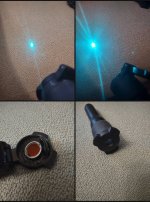Experiment success! There's been no melting on the 12$ Amazon go pro ND filter and id love to see someone come out with a stronger laser and try a darker filter. If you're afraid of melting, try getting multiple filters and stack them from ND4 next ND8 next ND16. I consider this a great alternative to multimode lasers especially since those give tons of divergence on them as a downside, yet to be proven.
Onto my laser ND8 is super glued to a 25$ rubber and plastic rifle scope cap I drilled a hole with a knife in and placed at an angle for reflections. When I close the cap with the laser on, it still flashes too bright and could be hazardous. Design flaw that. It also reflects the beam onto the host surface instead of back into the laser, idk if it would be a problem, it definitely isn't here now.
Math says 70 divided by 8 is 8.75 so I'm gonna guess and say my laser is reduced to 10mw an ND16 should reduce it to less than 5mw.
an ND16 should reduce it to less than 5mw.
Fun and bright still to play with and I can make it full power with ease.
No melting issues unlike the first batch of cheap NDfilters in a pack, melted almost immediately only noticable by dot divergence.
It would be cool to see someone take a stronger laser and reduce to a lower or safe level with this design. AND I consider this to be a great alternative to multimode lasers.
Onto my laser ND8 is super glued to a 25$ rubber and plastic rifle scope cap I drilled a hole with a knife in and placed at an angle for reflections. When I close the cap with the laser on, it still flashes too bright and could be hazardous. Design flaw that. It also reflects the beam onto the host surface instead of back into the laser, idk if it would be a problem, it definitely isn't here now.
Math says 70 divided by 8 is 8.75 so I'm gonna guess and say my laser is reduced to 10mw
Fun and bright still to play with and I can make it full power with ease.
No melting issues unlike the first batch of cheap NDfilters in a pack, melted almost immediately only noticable by dot divergence.
It would be cool to see someone take a stronger laser and reduce to a lower or safe level with this design. AND I consider this to be a great alternative to multimode lasers.






